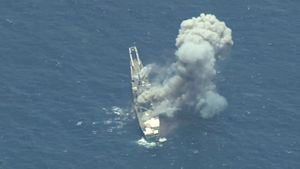On July 12, units from the United States, Japan, and Australia participated in a Sinking Exercise, or SINKEX during the biennial Rim of the Pacific exercise (RIMPAC) taking place in Hawaii and other locations around the Pacific. The exercise was the first-time land-based cruise missiles and rockets fired by the U.S. Army and the Japanese Ground Self Defense Force have participated in a SINKEX at RIMPAC.
The target hulk was the ex-USS Racine, a Newport-class amphibious ship designed to land tanks on beaches. Video from the exercise shows the hulk being struck by both air- and sub-launched air-launched missiles anti-ship cruise missiles, two different ground-launched cruise missiles, land-based artillery rockets, and a sub-launched torpedo.
Units from the Japanese Ground Self Defense Force’s Western Artillery fired Type 12 Surface to Ship Missiles at the target hulk. The Type 12 is the JGSDF’s most advanced coastal-defense cruise missile, travels at high-subsonic speeds, and has a range over 100 nautical miles.
Units from the U.S. Army’s 17th Field Artillery Brigade hit the target ship with a Naval Strike Missile fired from a truck-mounted launcher as well as rockets from the High Mobility Artillery Rocket System (HIMARS). The Army units utilized the Link-16 battle network to communicate with the joint units participating and an unmanned aerial vehicle to conduct spotting for its rocket artillery.
The U.S. Marine Corps has tested firing its own HIMARS from the deck of amphibious ships against targets ashore last year, and is exploring an anti-ship missile to fire from the platform, and in June the U.S. Navy chose the Naval Strike Missile as the primary anti-ship weapon to arm its Littoral Combat Ships.
The 17th Field Artillery is piloting the Army’s Multi Domain Task Force concept to address peer or near-peer threats that could deny access to U.S. and Coalition forces. The U.S. Army says that the concept seeks to overcome those adversary denial threats by integrating and synchronizing capabilities like unmanned surveillance assets, aviation, long-range artillery, air defense, electronic warfare, cyber, and space assets.
The SINKEX also demonstrated a long-dormant anti-ship capability for U.S. submarines with the USS Olympia launch of a Harpoon anti-ship cruise missile at the ex-Racine.
The Olympia is an older Los Angeles-class attack submarine, and its missile shot was unique because the sub-launched variant of the Harpoon missile was retired from U.S. submarines in 1997. Since then, U.S. submarines’ only anti-ship capability has been the Mk-48 heavyweight torpedo, but in 2015 U.S. Navy leaders said they were “taking steps” to deliver an anti-ship cruise missile capability for its submarine force again.
As the video of the sinking shows, a torpedo’s underwater detonation can inflict greater damage on a warship than missiles, but their range is comparatively limited. The U.S. Navy lists the Mk-48’s range as greater than five miles, while the Harpoon missile’s range exceeds 67 nautical miles.
Then-head of U.S. Pacific Command, Admiral Harry Harris announced the multi-domain SINKEX at a symposium for U.S. Pacific land forces last year, explaining that joint solutions to “fight our way through those contested environments where the Joint Force doesn’t necessarily possess a clear advantage” and ensure access in the lead up to a potential conflict. He said that integrating the coastal defense capabilities of the Japanese Ground Self Defense Force was meant to develop solutions to address archipelagic defense scenarios in the Western Pacific, where Japan’s Ryukyu island chain, stretching from the Home Islands to Taiwan, encircle most of China’s eastern coast.
As then-Under Secretary of the Navy Janine Davidson told USNI News in 2016, “The Army can be part of sea control. We keep thinking about the Navy as projecting power onto land because we’ve been doing that, especially in the last 15 years. But let’s think about it the other way around, and depending on what region you’re in, you’ve got a totally different fight.”

































